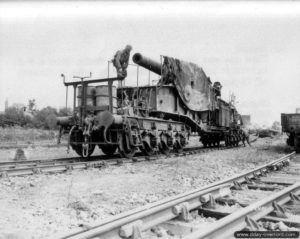Torigni-sur-Vire (Manche)
The cities of Normandy during the 1944 battles
The German 238mm « Theodor Bruno Kanone » railway platform gun being inspected by the Americans on August 2, 1944, at Torigni-sur-Vire station.
Photo : US National Archives
- Liberation: 31 July 1944
- Deployed units:
![]() 134th Infantry Regiment, 35th Infantry Division
134th Infantry Regiment, 35th Infantry Division
![]() 81st Chemical Battalion, 35th Infantry Division
81st Chemical Battalion, 35th Infantry Division
![]() 737th Tank Battalion
737th Tank Battalion
![]() 3. Fallschirmjäger-Division
3. Fallschirmjäger-Division
- History:
Bombed twice by the Allies on June 7 and 12, 1944, the town of Torigni-sur-Vire was devastated before its liberation by the deaths of several of its residents during these raids. Despite the dropping of leaflets urging the population to leave the housing projects, the majority of civilians remained in their homes as the bombings had not continued after June 7.
The Germans had installed a 238 mm caliber railway platform cannon named « Theodor Bruno Kanone » at Torigni train station, with a range of twenty kilometers. Initially deployed in Equeurdreville as part of the defense of Cherbourg, it had been repatriated to the area near Caen since May 1944 as part of the Eisenbahn-Artillerie-Batterie 722 following the increase in air raids along the coast. But the successive bombardments at Torigni-sur-Vire destroyed the railway lines, and the cannon became stuck there.
Several weeks after the start of the landings, the U.S. 5th Corps pushed the Germans southeast of Saint-Lô. The 35th Infantry Division, commanded by Major General Paul W. Baade, was stationed in defensive positions along the Saint-Lô-Bayeux road starting on July 19. Its regiments, after a short period of reconditioning, resumed their advance on July 27 toward Torigni.
By 5:00 p.m. on July 29, Colonel Butler B. Miltonberger’s 134th Infantry Regiment (IR) was only one kilometer north of the town. After a rapid alignment of his battalions, Miltonberger ordered the resumption of the advance shortly before 7:00 p.m. When the 3rd Battalion moved south of La Chapelle-du-Fest, it was violently attacked by artillery fire, halting its advance until July 30. The 1st Battalion was no more fortunate, despite its attempts to break through the German lines at 1:00 p.m. and again at 6:00 p.m. Artillery barrages and minefields pinned the Americans north of Torigni.
General Baade then called upon his artillery, particularly Battery C of the 81st Chemical Battalion. In preparation for the 134th Infantry Regiment’s offensive, scheduled to begin on July 31, the mortars fired phosphorus shells that set the village of Torigni ablaze. With the support of sappers tasked with detecting the possible presence of mines along the axes, the American infantrymen began their assault at 8:00 a.m., reinforced by tanks from Squadron C of the 737th Tank Battalion. The fire that broke out in the town released a significant amount of smoke, allowing the attackers to advance under cover of German observers. While the 2nd Battalion advanced from the north, the 3rd Battalion bypassed Torigni from the east, and the 1st Battalion began reconnoitering the village by following the road from Saint-Lô. Feeling overwhelmed and unable to repel their enemy, the Germans intensified their artillery barrage, focusing particularly on the town. Shells again fell on the houses, causing further civilian casualties.
Torigni-sur-Vire was captured in the evening by the 1st Battalion, the defenders of the 3rd Fallschirmjäger Division slipping south. The 3rd Battalion, after passing the village, was again stopped by an artillery barrage. On the evening of July 31, the 134th Infantry Regiment set up its defensive positions one kilometer south of Torigni, after encountering significant enemy resistance. The 320th Infantry Regiment then crossed the town and blocked the road to Guilberville for the night.
Torigni-sur-Vire map:
![]() Back to the Normandy cities in 1944
Back to the Normandy cities in 1944

